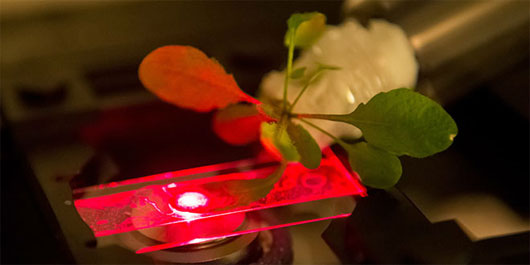Implant carbon nanotubes into plant cells to increase photosynthetic efficiency
Recently, a group of researchers at MIT implanted carbon nanotubes into organelles inside plant cells to improve the efficiency of plants' energy production .
The above method helps increase the performance of photosynthesis process by up to 30% and also creates trees for many other useful functions. The study promises not only to provide green energy production methods in the near future but also to be applied in many other areas of human life.
In a report published in Nature Material, the researchers said plants' ability to absorb light has increased by 30% after carbon nanotubes are attached to chloroplast organelles . This is where photosynthesis takes place in plant cells. The researchers call the method the first steps in the process of creating "nanotech plant power plants".

Photo: scinews.ro
"Plants are an attractive platform for science and technology development. They have amazing abilities like self-healing, growth," said lead researcher at MIT, chemical engineering professor Michael Strano . in harsh environments and can provide energy and water for themselves ".
Normally, even in the perfect environment, plants can only absorb about 10% of energy from sunlight at certain light wavelengths. After being implanted in chloroplasts in plant cells, carbon nanotubes enable cells to perform photosynthesis at more light wavelengths than ever before while allowing photosynthesis with efficiency. higher.
First, the researchers found a plant with a simple cell structure to easily implant carbon nanotubes. Finally, watercress plants have been selected as experiments. This type of plant has a single straight DNA that is often used in scientific experiments.
Later, the team wanted to monitor the effect of nanotubes on cell photosynthesis. To do this, the team used a dye that could change color when absorbing electrons. The results showed that not only electrons but also electric current generated during photosynthesis.
In addition to improving the performance of the photosynthesis process of cells. Researchers say it is possible to use the same method to implant nanoscale gas sensors inside cells. Sensors can detect toxic gases and give visual cues right on the tree for people to know. Initially the sensor can detect nitrous oxide, but in the future may detect many other gases.
The researchers say the method enables nanotechnology biologists and engineers to have a chance to cooperate with each other to improve the already excellent capabilities of trees to a new level. . This opens up prospects for completely green and clean energy plants in the future. At the same time, if widely applied, the above method can even create a healthier living environment for people.
- Increase the efficiency of photosynthetic reactions with nanoparticles
- Sensor chip made from carbon nanotubes
- Carbon nanotubes improve solar cell technology
- The calculator is made entirely of micro carbon nanotubes
- Self-cooling photovoltaic cells for increased efficiency
- 'Colored glass' carbon nanotubes are conductive and flexible
- Solar cell with nano-carbon technology converts heat into light, increasing efficiency to 80%
- Improve superconductivity with carbon nanotubes
- Manufacturing explosive detectors from carbon nanotubes
- People have known how to make carbon nanotubes 400 years ago
- New storage batteries based on carbon nanotubes
- Manufacturer of carbon nanotubes
 Why do potatoes have eyes?
Why do potatoes have eyes? 'Tragedy' the world's largest carnivorous life: Death becomes ... public toilet
'Tragedy' the world's largest carnivorous life: Death becomes ... public toilet Tomatoes were once considered 'poisonous' for 200 years
Tomatoes were once considered 'poisonous' for 200 years Detecting microscopic parasites on human face
Detecting microscopic parasites on human face